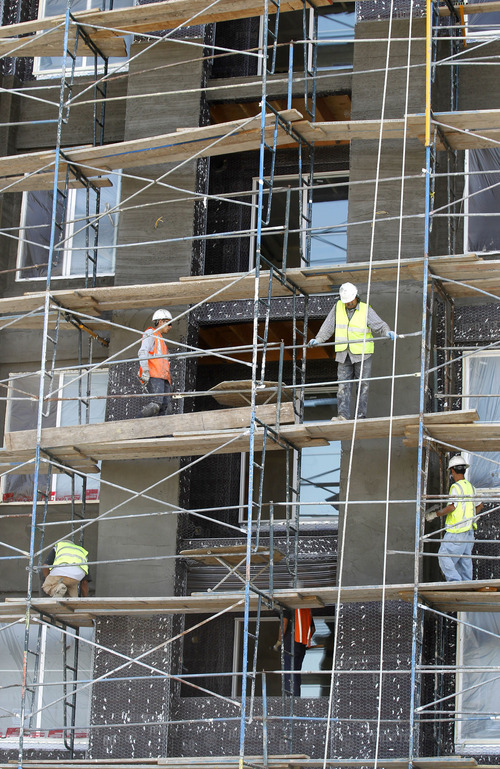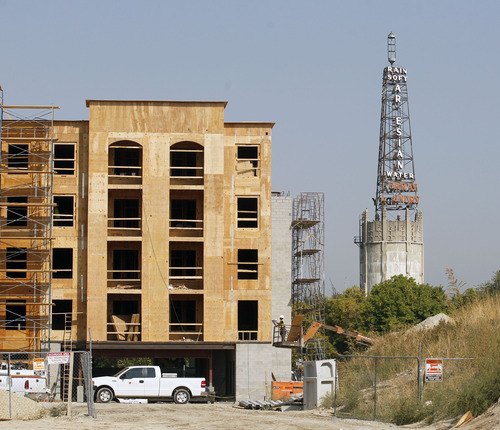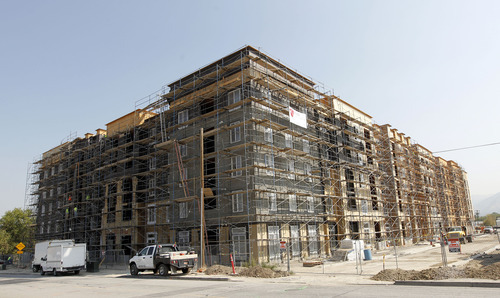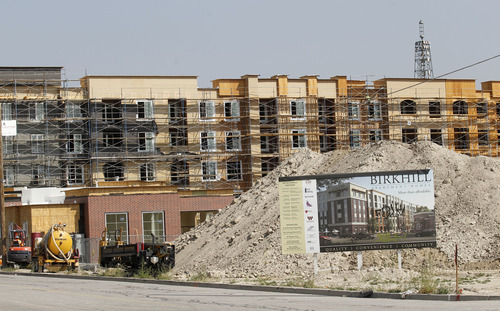This is an archived article that was published on sltrib.com in 2012, and information in the article may be outdated. It is provided only for personal research purposes and may not be reprinted.
Murray • When Mayor Dan Snarr took office, the city's center consisted of a series of dilapidated properties contaminated by smelters and other industrial waste several decades ago.
Now in the third year of his fourth and final term, Snarr is pleased to point out that those areas have been reclaimed.
"My goal was to get them all cleaned up before I left office, and that pretty well does it," Snarr said as he surveyed the multitude of high-density apartment complexes rising out of the ground in the city's 97-acre, transit-oriented Fireclay district, named for the brick factory that once operated there.
Birkhill on Main is among the newest round of multifamily residences that are sprouting on a former brownfield in the Fireclay area south of Big Cottonwood Creek.
A recent announcement from the national architecture and planning firm KTGY Group Inc. said that Birkhill's $17 million phase 1, which consists of 137 one- to three-bedroom apartments on five levels, will begin pre-leasing in October and should be occupant-ready by March.
The Ogden-based Kier Corporation is building the 664- to 1,119-square-foot units that are designed to be energy efficient and meet the Enterprise Green Communities Certification Standard. Features include 9-foot ceilings, gourmet kitchens, roomy closets, private patio/balconies and same-level parking.
Hooper Knowlton III — manager of Parley's Partners, the Salt Lake City firm overseeing Birkhill's development — touted Birkhill's structured parking garage in a recent statement.
"Never before offered in affordable housing in the Salt Lake City area," Knowlton said, "[it] provides immediate and convenient access to each resident's apartment home."
In addition, the urban apartments at 4255 S. Main St. sit just 1 1/2 blocks away from a TRAX light-rail station that connects riders to several destinations throughout the Salt Lake Valley.
Also, another transit station about seven blocks to the south soon will provide commuter-rail service south to Provo and north to Ogden.
Parley's Partners also plans to install a paved path on the project's north side that will tie in to the 40-mile Jordan River Parkway trail network.
By final buildout, the 6.2-acre, $45 million Birkhill development will add 174 more apartments in two additional phases — for a grand total of 311 units. Construction should finish by 2016 and, depending on market demand, could include a fourth phase offering three stories and 35,400 square feet of office space.
Birkhill also will feature an on-site clubhouse, courtyard, outdoor barbecues, basketball court, swimming pool and fitness center. In phase 1, 96 of the 137 units will provide affordable housing for tenants whose incomes qualify, with rents ranging from $335 to $811 per month.
Southwest of Birkhill in Fireclay, the Lions Gate Apartments continue to proliferate and, when completed in 2013, will provide a total of 668 living units in close proximity to TRAX.
"The philosophy of transit-oriented development is that the people who will be attracted to live there are either young singles or older empty-nesters," said Bob Springmeyer, president of Bonneville Research, a Salt Lake City-based consulting firm.
"The products are really designed to meet their needs," Springmeyer said, noting that Murray's nearby Intermountain Medical Center has driven interest and support for more rental housing.
"Until recently, we've seen declines in value in residential single-family homes and multifamily condos," Springmeyer said of the surge in apartment construction. "Lenders have been reluctant to loan on an asset declining in value."
Along with the new medical center, Murray is home to several major auto dealers, the Fashion Place mall and two transit stations. Springmeyer called the city of almost 48,000 residents, centered in the populous Salt Lake Valley where two interstate highways intersect, "extraordinarily well-positioned."
For Snarr, who frets over weed-infested lots and dilapidated properties, the city's makeover makes him grin — in spite of the frequent complaints he said he fields over too much traffic.
"When I took office, the heart of the city sucked," Snarr said. But now, he believes Murray's core will be "drop-dead beautiful."
"You consider that we'll double the population by 2040," Snarr said. "We've got to do something — and this is the future."
twitter: @catmck









